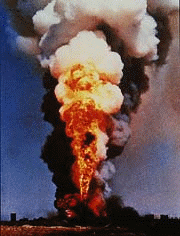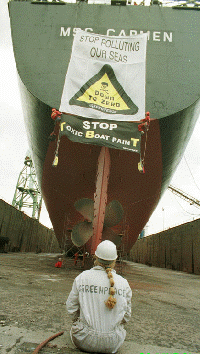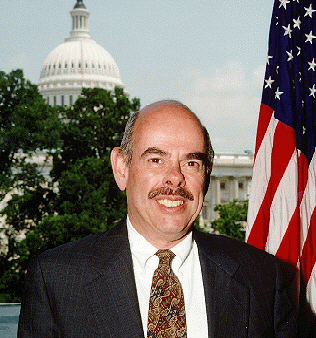Michael Fumento
Factual · Powerful · Original · Iconoclastic
Easy Reading
January 01, 2002 · Michael Fumento · The New Republic · Terrorism
Defenders of keeping the OCAs in reading rooms acknowledge that terrorists could use it to make a chemical plant explode; it’s a price they’re willing to have us pay.
"Chemical Plants are Feared as Targets." That was the headline of a frightening front-page article in the Sunday, December 16, Washington Post about the potential vulnerability of American chemical storage and production facilities to terrorists. "At least 123 plants each keep amounts of toxic chemicals that, if released, could form deadly vapor clouds that would put more than one million people in danger, according to an Environmental Protection Agency analysis," the newspaper reported. One example: "The Atofina Chemicals Inc. plant outside Detroit projects that a rupture of one of its 90-ton rail cars of chlorine could endanger three million people."
How did the Post obtain these details about potential mass homicide via toxic or flammable chemicals? Shoe-leather reporting? Sources at the FBI? Actually, no. A Post reporter, Guy Gugliotta, got the information by walking into an EPA "reading room" — one of about 50 scattered across the country and open to the public — flashing a photo ID, and signing a piece of paper. You could do the same thing. And so could any terrorist interested in prospecting for potential targets among the nation’s 15,000 chemical facilities.
If that thought spooks you, you’re in good company. In May 1999 Robert M. Burnham, then chief of the FBI’s Domestic Terrorism Section, told a congressional committee that public access to such extensive information about chemical waste would provide "a blueprint for a potential terrorist attack." The CIA, ATF, Justice Department, Secret Service, Fraternal Order of Police, and International Association of Fire Chiefs have offered similar warnings. But incredibly, even in the wake of September 11, neither Congress nor the EPA has taken the threat seriously enough to prevent public disclosure of the information. Following the attacks in New York and Washington, the EPA did remove general information about chemical facilities from its website. (Many other federal and state agencies pulled related material from their websites as well.) But the far more detailed information in the reading rooms is still available to anyone with a driver’s license.

Two militia groups, one involving the KKK, have already tried to blow up U.S. chemical facilities.
The ease with which this information can be accessed worries counterterrorism experts for two reasons in particular. First, as with the fuel-laden jetliners of September 11, the weapon is already there: No lethal chemicals need be smuggled into the country, carefully hidden, or expertly spread. Second, again like the suicide hijackings — which followed a series of similar, but unsuccessful plots — it wouldn’t be the first time terrorists targeted chemical facilities. In 1997 the FBI broke up a plot by four white supremacists to blow up a hydrogen-sulfide tank near Dallas. Two years later the agency arrested a militia leader and an alleged bomb maker for planning to blow up a propane storage facility outside Sacramento. And perhaps most disturbing was an explosion that ripped apart a petrochemical facility in Toulouse, France, just ten days after the World Trade Center collapsed. Three hundred tons of ammonium nitrate blew up, killing 29 people and devastating a chunk of the city. While the French government quickly declared it an accident, last October the minister of the environment claimed on television that "information [has] reached us which shows that there might have been a terrorist origin." (To date, the cause of the blast remains unexplained.)
In short, we know that chemical facilities in the United States have been targeted by terrorists in the past and that law enforcement agencies consider them vulnerable to attack today. We know that an attack undertaken with detailed knowledge of chemical toxicity, potential release rates, probable spread under particular wind conditions, etc., could have adverse health impacts on many thousands, perhaps millions, of Americans. And we know this information is publicly available in reading rooms across the country. "To put that out in a public venue is unconscionable," says John Eversole, formerly in charge of hazardous materials and terrorism for the Chicago Fire Department. "It cannot be rationalized by any sane person."
Federal "Right-to-Know" legislation dates back to the Emergency Planning And Community Right-to-Know Act (EPCRA) of 1986, which designated more than 600 toxic chemicals and required industries to reveal the amounts they released, both on- and off-site. The information was, and is, available on the EPA’s Toxic Release Inventory website.
But environmentalists complained that the information wasn’t specific enough. And so, in its 1990 amendments to the Clean Air Act, Congress required facilities that produce or store relatively large amounts of toxic or flammable materials to provide the EPA with "Risk Management Plans," or RMPs. Among other information, each RMP is required to provide an "off-site consequence analysis" (OCA) consisting of a "worst-case scenario" and a less drastic "alternative release scenario." (The term OCA is generally used to describe both sections, because they refer to potential harm to surrounding populations as opposed to that of employees.) For each chemical, the OCA provides information on potential release rates, total quantities that might be released, how the chemical would spread at certain wind speeds, and the maximum possible exposure the surrounding population might suffer — extraordinarily valuable information for a potential terrorist. As with the 1986 EPCRA legislation, Congress declared that the information should be available to the public, but left specific implementation of this mandate to the EPA.
As the deadline for companies to submit their RMPs approached, the EPA decided that the best way to make them public was to post them to its website, as it had done with the EPCRA material. The FBI sounded the alarm. Along with other law enforcement agencies, it stirred up such a fuss that the EPA was forced to back down. Jim Makris, director of the EPA’s Chemical Emergency Preparedness and Prevention Office, announced that the more sensitive OCA sections would not be Web-posted but would be made public in some other fashion. But the proposed solution — making the data available in electronic form through the Freedom of Information Act (FOIA) — didn’t seem much better, as nothing would prevent individuals or groups who obtained the material from posting it on their own websites.

Greenpeace is providing terrorists with one-click shopping by posting the OCAs to its website.
So shortly before the EPA was scheduled to begin releasing OCAs via FOIA requests, Congress heeded law enforcement protests and stepped in. In 1999 it passed legislation that prevented obtaining OCAs by FOIA or in any electronic format. Members of Congress then patted themselves on the back for having saved the Republic and went home. But the mandate to make the OCAs publicly available remained, and so one year later the EPA, having gone through the proper rule-making process, put them in the reading rooms.
At the time some observers realized that the problem hadn’t been solved. In his testimony, the FBI’s Burnham worried that "certain groups and individuals will acquire the information through lawful means [i.e., paper copies handed directly to recipients] and post it in its entirety on private Internet sites." Indeed, several advocacy groups had announced their intention to do just that — and at least one has made good on its promise. The Greenpeace USA website now has OCA data, gleaned from the Washington, D.C., reading room, for more than 50 chemical facilities, mostly in southern Louisiana. Greenpeace even provides handy maps that give the location of schools and hospitals in relation to the toxic plume. (My calls to the group’s head office went unanswered.)
So what is being done to prevent this information from falling into the wrong hands? Makris believes proper safeguards are in place. "Do you know the restrictions?" he asks emphatically. "You can only look at ten [OCAs] per month [outside of your own geographical region]. You can take notes but can’t walk away with paper copies."

The EPA says the requirement for photo IDs will keep terrorists out. At least seven of the September 11 terrorists had fake IDs.
Yes, I knew the restrictions. The week before I had gone to one of the reading rooms and obtained access to the documents using my Virginia driver’s license. (It bears noting that at least seven of the September 11 terrorists also had Virginia driver’s licenses, though none lived in Virginia.) My ID was checked against my face, but not against any list.
It’s true that visitors can view only ten documents from outside their own area per calendar month — but this is hardly onerous either. According to the reading room manager, some people come in on the last day of the month and the first day of the next month, thus gaining access to 20 documents in two days. More importantly, a would-be saboteur doesn’t need 10 or 20 or more OCAs; he only needs one. And finding the right one wouldn’t be hard: The EPA allows visitors to the reading rooms to conduct electronic searches by various criteria — including the types of chemicals produced or stored at the facilities in question. (The RMPs are printed out and given to the visitor.)
It’s also true that upon leaving the reading room you must return the downloads, at which point each page is meticulously counted and later shredded. But given that visitors are allowed to take notes as copious as they please, this restriction doesn’t mean much. I looked at a document that, at 85 pages, was apparently one of the longest in the system, and was able to copy down all the pertinent information in one hour. Someone with a palm-sized camera or camcorder could (illegally) record documents as fast as he could flip the pages. Nobody watches over you.

A small camcorder can tape pages as fast as you flip the pages.
Makris emphasizes that, whatever its limitations, the reading room system provides "a record of who shows up." But he concedes that this applies only to people who use legitimate IDs. He says that using information from the reading rooms for a terrorist attack "would certainly require a lot of intelligence and a lot of luck.... You’d have to hope the weather conditions would be ideal. You’d have to have detailed technical information. You’d have to know atmospheric stability." But isn’t that exactly the point? The OCAs, after all, offer detailed technical information.
In fact, Makris’s low estimation of the potential danger of making this information publicly accessible appears to contradict a joint risk assessment by the Department of Justice and the EPA itself, published in the Federal Register in April 2000. The assessment says that "traditional means of creating or obtaining [weapons of mass destruction] are generally difficult to execute," while "[i]n contrast, breaching a containment vessel of an industrial facility with an explosive, or otherwise causing a chemical release, may appear less difficult to a terrorist and may also appear attractive in light of the pervasiveness of industrial facilities possessing toxic or flammable chemicals and their proximity to high-population areas." While noting that "some of the OCA information that is cause for concern is already publicly available" — for example, that which is sent out by companies trying to reassure local populations — the joint assessment notes the particular risk associated with the material in the reading rooms: "Easy access to OCA information would be helpful to someone seeking to cause [industrial chemical releases] because it would provide ’one-stop shopping’ for refined targeting information, allowing terrorists to select potential targets from among the 15,000 facilities that have submitted OCA information."
Defenders of the current system argue that allowing public access to information about chemical plants also serves public safety — by informing people about the consequences of accidental release of hazardous material. As Representative Henry Waxman put it during the 1999 hearings, "we cannot keep this information out of the hands of terrorists without endangering people."

Rep. Henry Waxman: "We cannot keep this information out of the hands of terrorists without endangering people." Huh?
Waxman is right that there is danger on both sides of the equation. And it’s understandable that an accidental release seemed the greater threat in 1990, when the amendments to the Clean Air Act mandated public disclosure of the OCAs. Back then, the 1993 World Trade Center bombing, the Oklahoma City attack, and September 11 had not yet occurred; the tragedy on people’s minds was still the chemical release at a Union Carbide plant in Bhopal, India, that had killed 3,000 people six years earlier. (Ironically, a 1988 report conducted by the consulting firm Arthur D. Little backed up Union Carbide’s assertion that Bhopal itself was not an accident, but rather the result of inside sabotage.) But the intervening eleven years have surely shown that it is now terrorism that represents the greater concern. And yet the requirement for public access to vast amounts of detailed information about lethal chemicals remains law.
A better way to implement Congress’s public access mandate would be to restrict OCA access to persons living or working in the area. "The concept of right-to-know is that it’s for people affected, not for obtaining information about facilities thousands of miles away," says American Chemistry Council communications director Susan Roth. Others have suggested allowing those with the most to lose — the chemical facilities themselves — to maintain the OCAs and allow public access under more stringent restrictions. Best of all would be for Congress to revisit the 1990 legislation requiring public disclosure of RMPs altogether. (The information would, of course, still be made available to employees at the facilities themselves and to emergency response services.)
But closing the reading rooms — even temporarily — isn’t on anyone’s agenda on Capitol Hill. "As I understand it," says one staffer on the House Energy and Commerce Committee, which has oversight of chemical facilities, "you have to have photo ID, you can’t Xerox anything, and you’re only allowed to go in for a certain time [not true] and get ten documents. That’s a lot to go through." No, it’s a cakewalk. But don’t be too hard on her. After all, we used to think that presenting a photo ID, answering two questions about baggage, and walking through a metal detector was enough to prevent terrorists from attacking our airliners, too.
